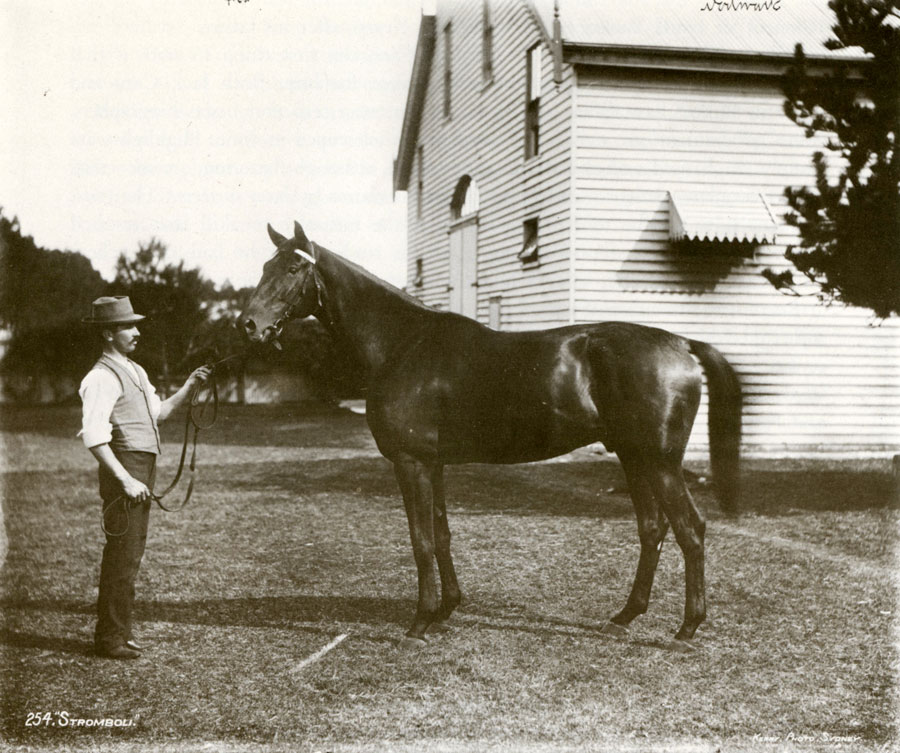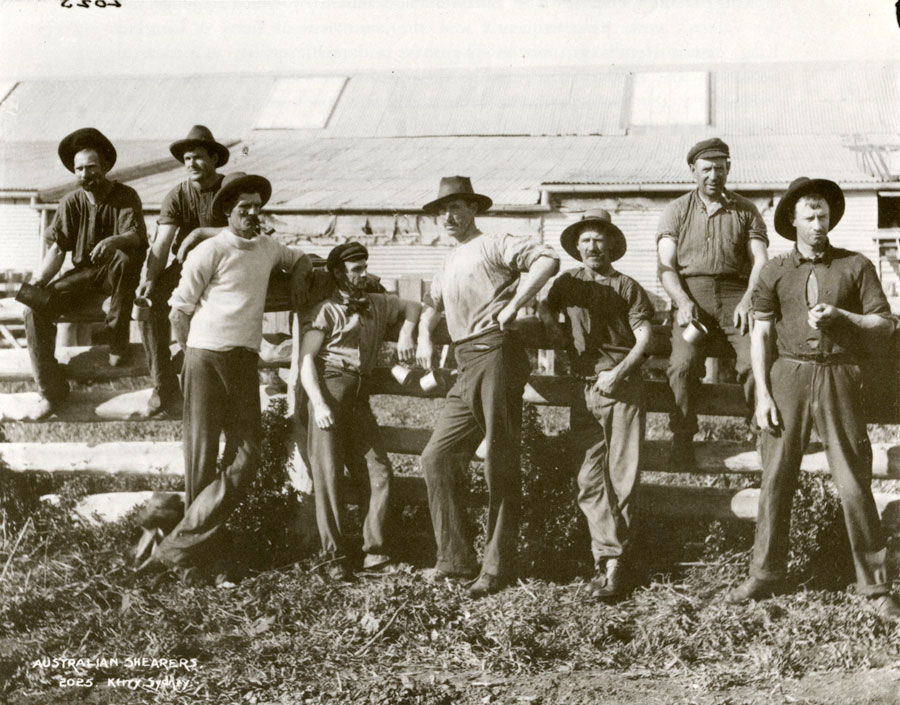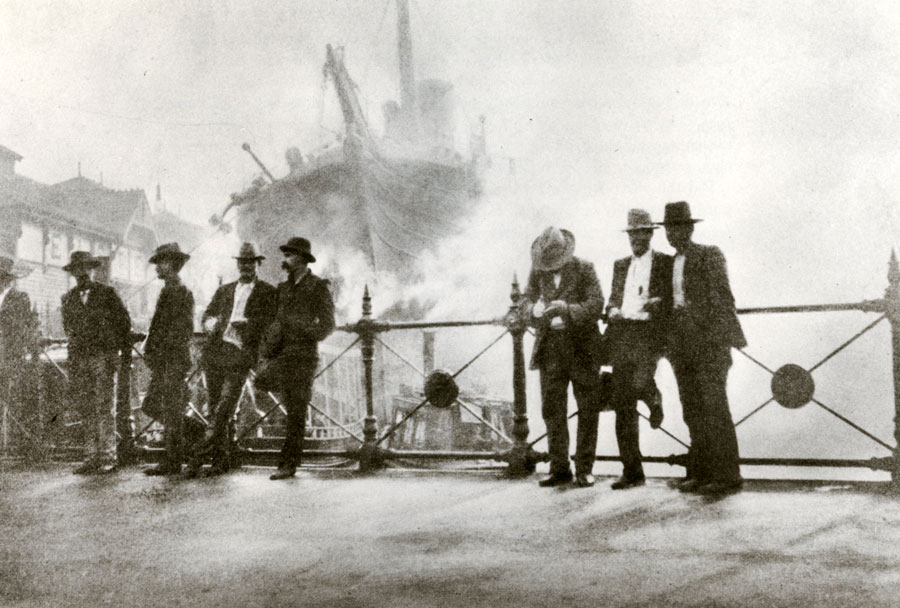|
cover & contents page | Rise & Fall of Kerry & Co | The Man & The Photographer | The Collection | The Plates | Biography | Kerry page
Charles Kerry, the man and photographer
When one turns to look at Kerry as a man, contemporary reports and present memories are unanimous. Tall, always smartly dressed but not foppishly so, he was a person with a great deal of energy, enthusiasm and sense of warm humour.
His wife, Delphine Vivian, the daughter of a former Town Clerk of Sydney, was a dark-eyed, raven-headed beauty, whose striking appearance was frequently remarked upon. It was a romantic family belief that her looks were descended from the union of a Cornish girl and a Spanish survivor of the Great Armada. Their son, Marni Kerry, was the only issue of the marriage.
Kerry was, par excellence, the practical man. He enjoyed nothing more than experimenting with new photographic techniques or equipment. Thus, for instance, when Willem van der Velden plucked up courage to ask Kerry for assignments, as a test Kerry expected him to master and mend an erratic and cumbersome whole-plate camera and still come up with good pictures of the recently renovated Town Hall.1 It was a test that Kerry would have relished for himself.
Kerry was enthusiastic about outdoor life. Mention has already been made of his explorations in the limestone caves of the Blue Mountains.2 He enjoyed horse-riding and became a member of the New South Wales Lancers.
An expert gun shot, he won the open handicap pigeon shoot of New South Wales for twelve consecutive months during 1893-94. Trout fishing and rod angling took him off to many streams and lakes. In the history of Australian skiing, Kerry was an important figure.
He promoted snow sports and organised winter parties to Kiandra. He pressured, with others, for the construction of a road from Kiandra to Kosciusko summit, and the building there of a hotel – Hotel Kosciusko. He led the first party to reach the summit of Kosciusko under winter conditions in 1897.3
 |
Stromboli
Charles Kerry was a keen horseman and he built up a large business photographing stud, show and race horses. This is Stromboli, who won the Sydney Cup in 1892 in a time of 3.35 minutes over 16 furlongs (3.2 km). Stromboli was a Bay horse bred in 1888 by Chester from Etna. Raced by J. B. Clark, he won the AJC Derby, the AJC Sires Produce Stakes and the VRC Sires Produce Stakes. His progeny were of no account on the racecourse.
|
Photographing in the snow posed technical problems which Kerry enjoyed solving. He discovered that the only way to stop halation of negatives in such cold conditions was to keep the plates in warm blankets. To get a good image, exposures needed to be three times longer than normal.4
Unlike his great rival, Barnett of Falk Studios, Kerry was not involved with the theatrical world or on intimate terms with painters and writers. His friends were graziers, sports-minded men and businessmen. He accordingly belonged to the Millions Club and the Masons. Kerry's son, Marni, was flattered by the decision of Sir Frank Packer to name his son, Kerry, after his father.
When one looks at Kerry the photographer, the first thing to note is that subsequent writers have made erroneous claims for him. Both Jack Cato and Quentin Burke5 have fallen into the most common trap that besets biographers. With good intentions, events are unwittingly telescoped in time.
Highlights are unduly emphasised and claims are made which, although flattering, are incorrect. Such treatment results in errors and erroneous claims by later writers.6 The most frequent is to ascribe to Kerry, personally, the initiative or skill that resulted in the large output of photographs from his studio, as if he had taken them all himself. In fact, after 1895, Kerry took very few photographs.
Kerry was a member of a profession whose studios developed an entrepreneurial style and which, between 1890 and 1910, experienced its golden age. In Sydney, it was represented in 1898, for instance, by firms like the new Eden Studio, Bernard's Swiss Studio, Grouzelle's, Messrs Levy and Allen at one end of the Strand and Farrell's Tosca Studios at the other end, as well as the famous Falk Studios, Henry King's Studio Rooms and Kerry & Co.
These were all reasonably large business concerns, with the management pretty exclusively committed to administration, public relations and policy. Kerry's was no exception. By 1890 it is clear that an ever-increasing amount of work printed in the name of Kerry was, in fact, being photographed by his field operators – Bell from 1890, Bradley from 1891, and van der Velden from 1907. Later generations might question the ethics of such a workshop situation, but it was then regarded as normal.
Because there is no individual record of who photographed or printed what, it is impossible to know where Kerry's actual photographic contribution begins or ends. The situation is not helped by the relevant paucity of Kerry's residual collection, when compared with the thousands of negatives that would once have been stacked in their special shelves in the top floor of 310 George Street.
There are, however, some tentative leads. Van der Velden's photography is what one would expect from a man whose interest was in the chemistry and hardware of photography. They are straightforward, predictable, dull, if workmanlike photographs of High Victorian and Edwardian Sydney. There is no interest in atmosphere, the light is consistently bright, and the viewpoint is high – made possible by the special mobile scaffolding from which the photographs were taken. One can only compare Van's photographs with the work of a contemporary photographer of views, Henry King.
Some of King's negatives are contained in the Tyrrell collection, having been purchased originally by Kerry's on the demise of King's studio.7 They form an unfavourable standard by which to judge van der Velden's work. King frequently took the same views as Kerry & Co., but King's results are always superior. They have a dramatic quality – a sense of occasion – and a content that captures the eye and nourishes the imagination.
Bradley is the photo-journalist. From the few works known to be by him, it is not easy to observe any stylistic trend.
This is not the case with George Bell, whose photographs of life in the outback have a considerable romantic quality. Including both posed genre and reportage, they record the Australia of 'Banjo' Paterson and illustrate the life of the golden age of the outback which was to feed the national myth for several decades.
The question that remains unanswered is, to what extent did Kerry lay down a house style of photography that others dutifully, if happily, followed? Or did Kerry accept their work as a useful contribution to the firm's daily life?
That Kerry could take a good photograph is not doubted. His documented reporting of the Aboriginal corroboree puts paid to any fears on that score. What one is left with is the infuriating convention of the time, whereby the entrepreneurial, photographic businessman imposed a house name and anonymity upon all contributors to the firm's output.
It remains to ask – why did Kerry forsake photography for mining? I think, basically, because he was a businessman first and a photographer second. His early enthusiasm for the craft had been surpassed by an enthusiasm for making money from minerals rather than from dry plate negatives.
To say so is not to condemn him; it is simply to state that he was a typical product of the Victorian age of photography, who saw photography as one of many avenues by which the goal of a flourishing business could be pursued.
But times were changing. Harold Cazneaux, who had begun to work at Freeman's Studios in 1904, refused to accept a ruling by his employer that all his own work, done in his own time, should be printed under the name of Freeman. From that standpoint Cazneaux progressed, until in 1909 he mounted his first one-man show at the rooms of the Photographic Society of New South Wales.
The exhibition 'if not the first such show... was probably the first to establish the idea of the photographer artist'.8
 |
Australian Shearers
Shearers were a colourful, full-blooded group of men, who dominated the itinerant groups that crossed the country. From the 1890s they became increasingly militant as they fought for better deals and conditions from the pastoralists. The conflicts were frequently long and bitter.
|
 |
Wharfies, Circular Quay, Sydney
Harold Cazneaux
|
The days of the entrepreneurial photographer with his vast studio setup were soon to end. There were other straws in the wind. In 1904 The Australian Photographic Journal published a dramatic photograph by Alfred A. Steiglitz of a steam train — 'The Hand of Man'.9 As founder of the Photo-Secession in 1902 in the United States, Steiglitz was to become an internationally known promoter of the new style of Pictorial photography and the new breed of artist-photographer.
In 1906 Norman C. Deck, an Australian pioneer of Pictorialism, gained considerable coverage in The Australian Photographic Journal.10 His friend, J. F. (Frank) Hurley, later to win fame and a fortune through his coverage of the Mawson and Shackleton Polar expeditions, had already had dramatic Pictorial photographs published in the same journal,11 while the patriarch of Australian Pictorialism, John Kauff-man of Adelaide, was consistently having work published in the journal from 1903.
The trend of photography was moving away from the cliched portrait, the sentimental genre and the dull reportage of the more pedestrian entrepreneurial photographers of the Victorian studios.
Did this affect Kerry? Did the prominence given to Pictorialism's most competent practitioner in Australia, Harold Cazneaux, in The Australian Photographic Journal of October 1908, give Kerry an inkling that something far more threatening than the once-new techniques of the Falk Studios was to challenge the studios of Victorian photography, with their sweated labour, canvas scenery and unsmiling family portraits?
We may never know. All we can say is that by leaving photography when he did, he was saved the anxiety of readjusting to a new fashion that was soon to sweep Australia.
Significantly, his worthy operators, Bell, Bradley and van der Velden, who stayed in the photographic tradition he helped build, would all be yesterday's men by the 1920s. The new breed, nurtured in the Sydney Camera Circle, and emulating their most notable member, Harold Cazneaux, were where the future lay.
References
- The Australasian Photo-Review, Aug 1954, p. 468
- See above, p. 17
- Ski Australia, June 1969, pp. 43-75; The Australian Ski Year Book, 1928, no. 1., pp. 43-57; The Australian Photographic Journal, April 1896, pp. 74-76; Aug 1896, p. 179 (illus)
- The Australian Photographic Journal, Aug 1896, p. 178
- Jack Cato, The Story of the Camera in Australia, Georgian House, Melbourne, 1955, pp. 65-69; Quentin Burke, 'Charles Kerry', The Australasian Photo-Review, March 1952, pp. 142- i58.There are frequent allusions to Kerry being the photographer, when 'Kerry & Co.' would have been correct.
- See I. & C. Pearl. Our Yesterdays: Australian Life since 1853 '" Photographs, Angus & Robertson, Sydney, 1967, p. 2, pp. 110-113. Photographs are ascribed to Kerry which were taken by Henry King and George Bell.
- Harold Cazneaux to Jack Cato, March 28 1951. Letter 3, Cazneaux family MSS
- Gael Newton, Australian Pictorial Photography. Catalogue, Art Gallery of New South Wales, 1969, p. 8
- The Australian Photographic Journal, Nov 1904, p. 246
- The Australian Photographic Journal, Nov 1906, pp. 26if
- The Australian Photographic Journal, June 1906, p. 129, pp. 132-3
>>cover & contents page | Rise & Fall of Kerry & Co | The Man & The Photographer | The Collection | The Plates | Biography | Kerry page
|